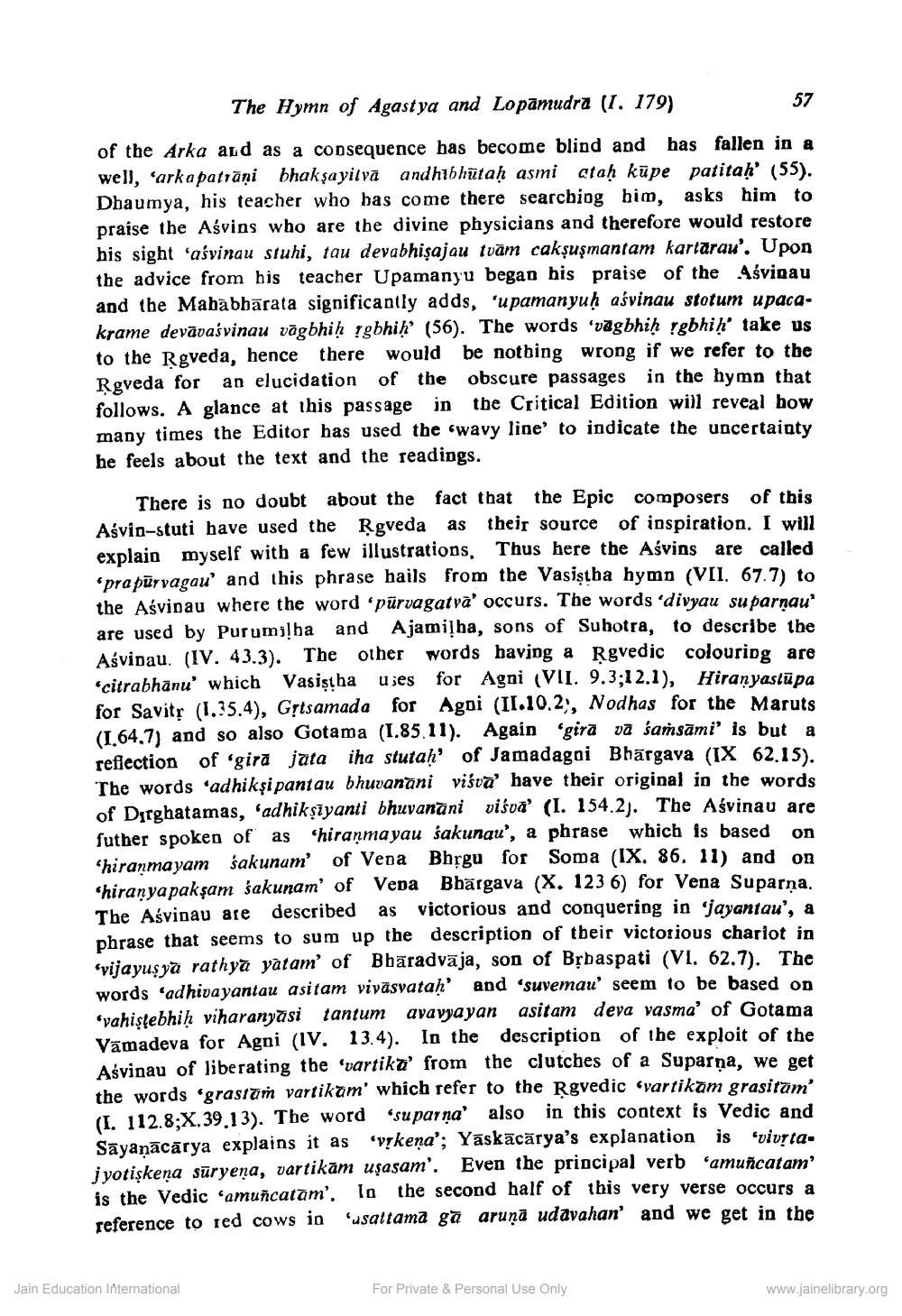________________
The Hymn of Agastya and Lopamudra (I. 179)
57
of the Arka aud as a consequence has become blind and has fallen in a well, 'arka patrāņi bhakşayilva andhibhūtah asmi ataḥ kūpe patitah (55). Dhaumya, his teacher who has come there searcbiog him, asks him to praise the Asvins who are the divine physicians and therefore would restore his sight 'aśvinau stuhi, tau devabhișajau tvām cakşuşmantam kartārau'. Upon the advice from his teacher Upamanyu began his praise of the Aśvinau and the Mababbārata significantly adds, 'upamanyuḥ aśvinau stotum upaca. krame devāvasvinau vāgbhiḥ ìgbhiḥ (56). The words 'vägbhiḥ rgbhiḥ take us to the Rgveda, hence there would be nothing wrong if we refer to the Rgveda for an elucidation of the obscure passages in the hymn that follows. A glance at this passage in the Critical Edition will reveal how many times the Editor has used the wavy line' to indicate the uncertainty he feels about the text and the readings.
There is no doubt about the fact that the Epic composers of this Asvin-stuti have used the Rgveda as their source of inspiration. I will explain myself with a few illustrations. Thus here the Asvins are called *pra pūrvagau' and this phrase hails from the Vasiştba hymn (VII. 67.7) to the Aśvinau where the word 'pürvagatva' occurs. The words 'divyau su parnau are used by Purumi!ba and Ajamilha, sons of Subotra, to describe the Asvipau. (IV. 43.3). The other words having a Rgvedic colouring are 'citrabhānu' which Vasiştha ujes for Agni (VII. 9.3;12.1), Hiranyastupa for Savitr (1.35.4), Gștsamada for Agoi (I1.10.2), Nodhas for the Maruts (1.64.7) and so also Gotama (1.85.11). Again ‘gira va saṁsāmi' is but a reflection of 'gira jata iha stutaḥ' of Jamadagai Bhargava (IX 62.15). The words 'adhikşi pantau bhuvanani višva' have their original in the words of Darghatamas, 'adhikṣāyanti bhuvanāni visva' (I. 154.2). The Asvinau are futher spoken of as ‘hiranmayau sakunau', a phrase which is based on "hiranmayam sakunum' of Veda Bhrgu for Soma (IX. 86. 11) and on ‘hiranya pakşam sakunam' of Veda Bbārgava (X. 1236) for Vena Suparna. The Aśvinau are described as victorious and conquering in 'jayantau', a phrase that seems to sum up the description of their victorious chariot in 'vijayusya rathya yatam' of Bharadvāja, son of Brbaspati (VI. 62.7). The words 'adhivayantau asitam viväsvataḥ' and 'suvemau' seem to be based on vahistebhih viharanyasi tantum avavyayan asitam deva vasma' of Gotama Vāmadeva for Agni (IV. 13.4). In the description of the exploit of the Asvinau of liberating the vartika' from the clutches of a Suparna, we get the words 'grastum vartikam' which refer to the Rgvedic 'vartikām grasitām' (I. 112.8;X.39.13). The word “suparna' also in this context is Vedic and Sayanācārya explains it as 'vrkena'; Yāskācārya's explanation is vivrta. i votiskena suryena, vartikām uşasam'. Even the principal verb 'amuñcatam' is the Vedic Camuñcatam'. In the second half of this very verse occurs a reference to red cows in usattama ga aruņā udavahan' and we get in the
Jain Education International
For Private & Personal Use Only
www.jainelibrary.org




